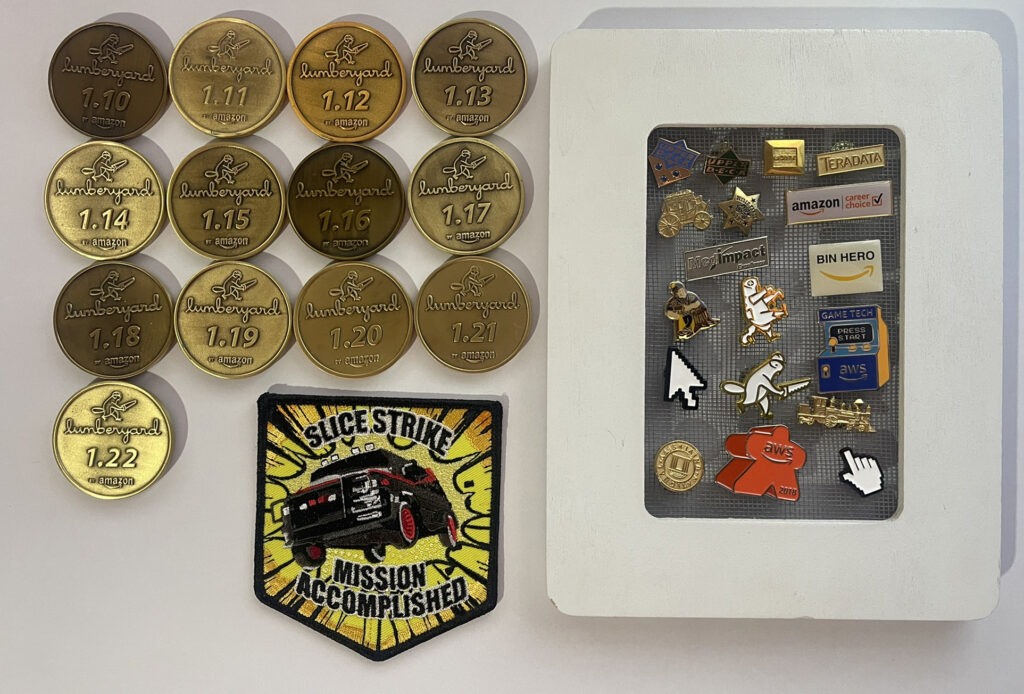Patents and Achievements
Public awards



Kuddos from the community
Trophies


Patents

- Patents: Component entity system (11,625,229),
- Physics interaction management for virtual environments (11,654,363),
- Prefab template system (16,049,145 – pending),
- Entity hierarchies and layers (pending),
- Component property pinning for template and instance system (pending),
- Nested game object containers for asset systems (pending)
Lessons learned
During my nearly 9-year tenure at Amazon, I’ve been part of 10 different products, hundreds of features, and product releases. I’ve guided product direction from start to finish, designed vastly different workflows for diverse customer segments, and both created and contributed to various design systems. I’ve had opportunities to influence not only the products I’ve worked on but also those of other designers. I’ve been a mentor, found unique mentors from the video game industry, and served as a company representative at universities and on showroom floors. Most importantly, I’ve spent thousands of hours listening to our customers, developers, and product teams, acting as a facilitator of ideas and patterns.
- Here are some of the most important lessons I’ve learned, interpreted through Amazon’s leadership principles from a UX perspective:
- Customer Obsession: Never take anything personally. Detach yourself from your work. People may dislike an iteration or design, and that’s okay. My job is to align with the customer’s needs. Often, those who dislike something offer a unique perspective and an opportunity to learn and grow.
- Ownership: As a product owner, consider the long-term strategic needs of your customers. Don’t get caught up in short-term roadmap feature improvements. It’s a marathon, not a sprint. Make a plan, validate your understanding, and own the long-term push towards those goals. Consistent effort towards your vision will lead to success.
- Invent and Simplify: Don’t fear trying something new or discarding designs that aren’t working. View your work through your customers’ lens; if it’s not working, try something new. Great innovations come through experimentation and change.
- Are Right, A Lot: As the customer’s advocate, you represent hundreds, if not thousands, of users. You must correct other stakeholders’ understanding of the customer’s journey and needs. This can only be achieved by listening to and learning from your customers.
- Learn and Be Curious: As a designer, I often ask, “What if…?” What if we tried this instead of that? What if we got it wrong? What if there are more use cases we haven’t explored? This openness to new ideas leads to innovation, which happens at the crossroads of curiosity and learning.
- Hire and Develop the Best: In mentoring designers, I focus on sharing experiences that can’t be taught from a book. By sharing my successes and failures, I help the next generation of designers become more proficient and better equipped for the future.
- Insist on the Highest Standards: As a designer, don’t accept arbitrary rules without question. Validate and push back respectfully when necessary. Higher standards are often controversial, but it’s important to dig deep while remaining respectful.
- Think Big: Be adaptable in the design process. Think bigger about goals and prioritization. Sometimes, setting something aside and switching gears can help the entire team be more effective.
- Bias for Action: As a designer, you’ll receive tons of feedback. Don’t let inaction stop you. Decisions are rarely irreversible, so believe in your direction. Pick a heading and be brave.
- Earn Trust: This is perhaps the most important principle. Success in building anything requires all stakeholders. Be a good teammate, listen, reflect, and give everyone an equal voice. Earning trust also means having a strong backbone and standing up for what you believe in.
- Dive Deep: Immerse yourself in your customer’s experience. Understanding every aspect and putting yourself in their shoes helps identify their struggles. Great designers are distinguished by this characteristic.
- Have a Backbone; Disagree and Commit: Standing up for what’s right matters. It doesn’t mean being argumentative, but rather voicing the correct decision even if it leads to uncomfortable conversations.
- Deliver Results: Getting to the finish line can sometimes feel impossible, but your job is to persevere. We won’t always get everything right, and that’s okay. Your ultimate job is to finish what you started. Lessons learned will come, but so will growth and new opportunities.
- Success and Scale Bring Broad Responsibilities: As you grow in your role and take on new responsibilities, embrace change. Take time to reflect and learn from these new opportunities. You’ll discover strengths you didn’t know you had and areas where you can improve. It will bring moments of reflection and ways to know more about yourself and your working style.
By adhering to these principles, I’ve grown as a designer and leader, continually improving my ability to create user-centric products and mentor the next generation of UX professionals.“











